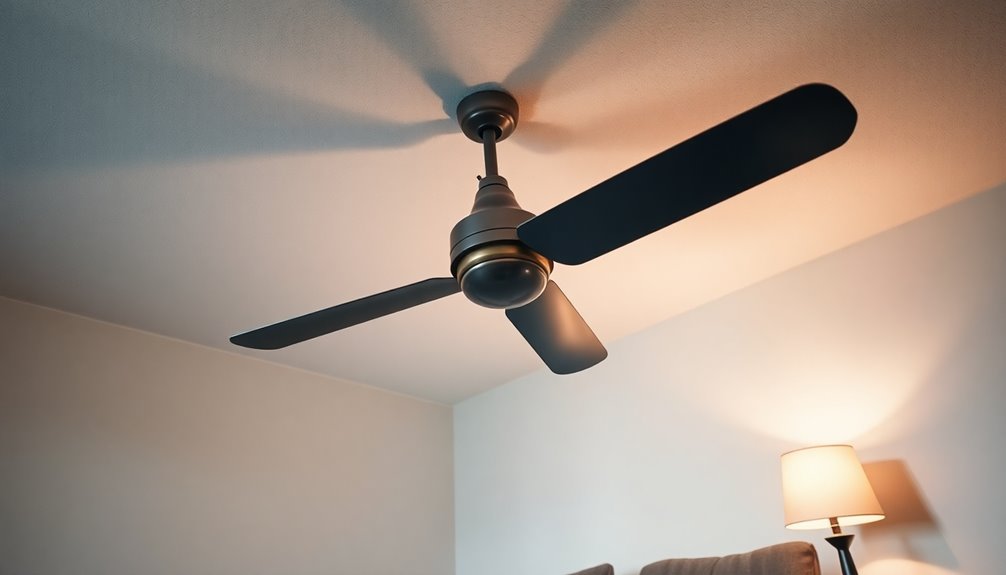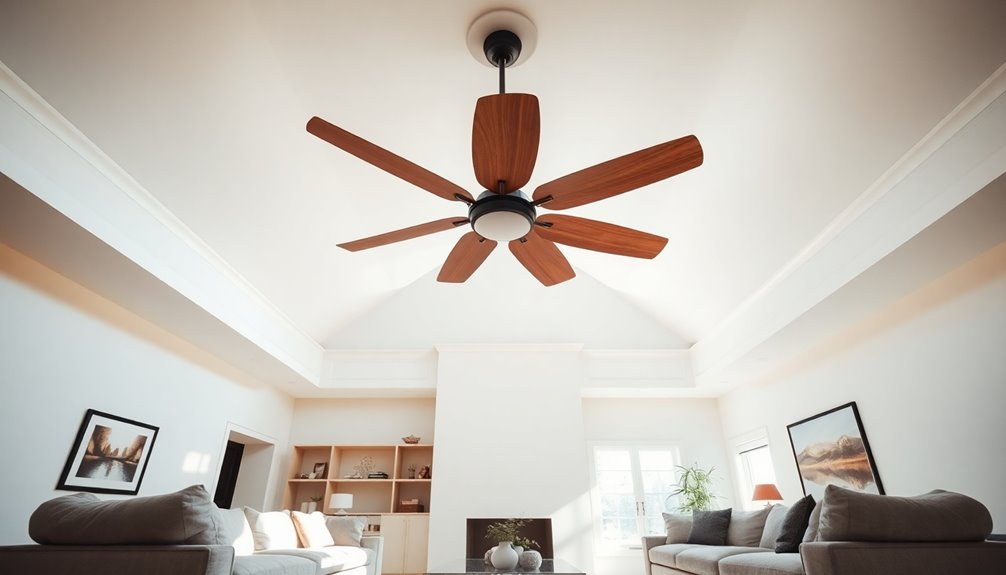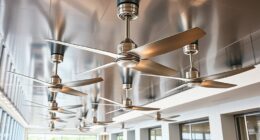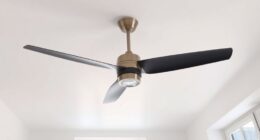Yes, you can use both your air conditioner and ceiling fan together for increased comfort and energy savings. Operating a ceiling fan lets you set your thermostat about 4°F higher without losing that cool feeling. Fans create a wind chill effect, making you feel 5-7°F cooler. This combination helps reduce the workload on your AC, promoting better efficiency and longevity. Plus, you might see a drop in your energy bills. For best results, check how to adjust settings based on seasons and gather other tips to enhance your cooling system.
Key Takeaways
- Yes, using both an air conditioner and ceiling fan together enhances comfort and reduces cooling costs effectively.
- Ceiling fans allow you to set the thermostat up to 4°F higher without compromising coolness.
- Running a ceiling fan costs significantly less than operating an air conditioner, promoting energy savings.
- Proper fan direction and seasonal adjustments maximize efficiency and comfort in both summer and winter.
- Turn off ceiling fans in unoccupied rooms to avoid wasting energy, using them strategically in occupied spaces.
Benefits of Combined Usage

Using an air conditioner and a ceiling fan together can boost your comfort and save you money. This combination allows you to set your thermostat higher—up to 4°F—without feeling any loss in coolness.
With a ceiling fan costing about 1 cent per hour to run, compared to the 36 cents for an air conditioner, you can achieve significant energy savings.
Ceiling fans enhance air circulation, effectively distributing the cooled air throughout your room. This improved airflow helps reduce the workload on your AC unit, which can lead to longer-lasting equipment and lower maintenance costs.
Plus, the wind chill effect created by a ceiling fan can make you feel 5-7 degrees cooler, allowing you to increase your thermostat setting even more.
How to Use Them Together

To make the most of your air conditioner and ceiling fan, adjust your thermostat setting up to 4°F higher while the fan's running.
This combination not only keeps you comfortable but also saves you money on energy costs.
Optimal Temperature Settings
When you combine an air conditioner with a ceiling fan, you can easily adjust your thermostat for better energy efficiency without sacrificing comfort.
This clever pairing allows you to set your A/C 4°F higher while still feeling cool. Here are some ideal temperature settings to take into account:
- Set your A/C to 76°F: With the ceiling fan on, it feels like 72°F.
- Use the fan only in occupied spaces: It circulates air but doesn't lower the room temperature.
- Turn off the ceiling fan when you leave: Since it doesn't cool the air, running it unnecessarily wastes energy.
- Enjoy potential monthly savings: By raising your A/C temperature, you can save around $30 during hot seasons.
Energy Cost Benefits
How can you maximize your cooling efficiency while keeping costs down? By using both your air conditioner and ceiling fan together, you can enjoy significant energy cost benefits.
You can raise your A/C thermostat setting by up to 4°F without sacrificing comfort, which can save you money on cooling costs. For instance, if you set your A/C at 76°F while running a ceiling fan, it creates a cooling effect similar to 72°F, allowing you to feel just as comfortable.
The financial advantage is clear: the average cost of running an air conditioner is about 36 cents per hour, while a ceiling fan only costs around 1 cent per hour. By reducing the workload on your A/C unit, you might lower your monthly energy bills by around $30 during hot seasons.
To further quantify your savings, consider using an online calculator to monitor your energy usage. This way, you can see just how much using both systems together can save you.
In short, combining an air conditioner with a ceiling fan is a smart strategy that keeps you cool and helps you save money.
Importance of Thermostat Adjustment

Adjusting your thermostat is key when using both an air conditioner and a ceiling fan.
By raising the temperature setting a few degrees, you can enjoy comfort without sacrificing your budget, potentially saving around $30 monthly.
This simple adjustment not only reduces your air conditioner's workload but also maximizes your energy savings.
Optimal Thermostat Settings
Maximizing comfort and energy efficiency in your home often hinges on the thermostat settings.
When you're using both an air conditioner and a ceiling fan, adjusting your thermostat can make a significant difference.
Consider these tips:
- Raise the thermostat by 4°F: If your air conditioner is set to 76°F, bump it up to 80°F.
- Utilize the ceiling fan: It enhances air circulation, making the room feel 5-7 degrees cooler.
- Enjoy the wind chill effect: This effect allows you to feel comfortable even at higher thermostat settings.
- Save on energy costs: For every degree you increase your thermostat, you could reduce cooling costs by around 3%.
Energy Savings Potential
Often, many homeowners overlook the substantial energy savings that come from adjusting their thermostat when using both an air conditioner and a ceiling fan. By raising your thermostat setting by up to 4°F, you can maintain comfort while reducing the workload on your air conditioning system. For instance, if you set your A/C at 76°F, you can increase it to 80°F with a ceiling fan running, cutting down on energy consumption.
Here's a quick comparison of costs:
| Setting | A/C Cost per Hour | Ceiling Fan Cost per Hour | Total Cost per Hour |
|---|---|---|---|
| A/C at 76°F | $0.43 | $0.01 | $0.44 |
| A/C at 80°F | $0.26 | $0.01 | $0.27 |
| Savings per Hour | – | – | $0.17 |
| Monthly Savings | – | – | $30 |
Comfort Without Sacrifice
Finding the right balance between comfort and energy savings is easier than you might think when you use your air conditioner in tandem with a ceiling fan.
By adjusting your thermostat, you can enjoy a cooler feel without sacrificing comfort or breaking the bank. Here's how to optimize your setup:
- Raise Your Thermostat: Increase your air conditioner's setting by 4°F. For example, if it's at 76°F, bump it up to 80°F while using the ceiling fan. This adjustment can significantly reduce your cooling costs, akin to the energy savings seen with geothermal heat pumps. Additionally, this strategy works well because heat pumps are designed to operate efficiently even at higher thermostat settings. This is particularly important for commercial grade heat pumps that need to manage larger temperature variances.
- Embrace the Wind Chill Effect: The ceiling fan creates a breeze that makes the air feel cooler on your skin, maintaining comfort. Additionally, using heat pumps can provide an even more efficient cooling solution, allowing for enhanced energy efficiency.
- Reduce Energy Consumption: This adjustment lowers your cooling system's workload, potentially saving you about $30 monthly during hot seasons.
- Extend Equipment Lifespan: Lowering your air conditioner's runtime can improve its efficiency and longevity.
Additionally, combining the use of ceiling fans with air purifiers can further enhance your indoor air quality, providing a healthier living environment for you and your family, especially for allergy sufferers.
Energy Cost Considerations

Combining an air conditioner and a ceiling fan is a smart strategy for cutting energy costs. When you run a ceiling fan, it only costs about 1 cent per hour, while your air conditioner can rack up around 36 cents per hour. By using both, you can considerably reduce your overall expenses.
Raising the A/C thermostat by 4°F while the ceiling fan runs helps maintain comfort and can save you around $30 each month during hot seasons.
Additionally, the ceiling fan creates a wind chill effect that keeps your space feeling cooler without actually lowering the air temperature. This allows you to set your thermostat higher, leading to even more savings. For every degree you increase the A/C setting while using the ceiling fan, you could save up to 3% on your monthly cooling costs.
Moreover, using both appliances together decreases the A/C's workload, enhancing its efficiency and extending its lifespan.
Common Misunderstandings

Here are four key misconceptions you might encounter:
- Ceiling Fans Cool the Air: Many think ceiling fans lower the temperature in the room, but they actually create a wind chill effect that makes you feel cooler without changing the air temperature. This effect can complement an air purifier's ability to improve overall air quality.
- Increased Cooling Load: Some assume that running a ceiling fan with an air conditioner increases the cooling load. In reality, fans help evenly distribute the cooler air, allowing you to set the thermostat higher. This can also enhance the efficiency of your air purifier by ensuring even air circulation.
- Continuous Operation: It's a common belief that ceiling fans should run all the time. However, they're most effective when used in occupied spaces and should be turned off when no one is present to save energy. Regular maintenance of both fans and air purifiers can help them operate at peak performance.
- Wasteful to Run Both: Many think using both systems together is wasteful. In fact, a ceiling fan can reduce reliance on the air conditioner, leading to significant energy savings over time. Additionally, using a ceiling fan can reduce energy bills by up to 50%, making it a smart choice for enhancing overall energy efficiency.
Tips for Optimal Performance

To get the most out of your air conditioner and ceiling fan, you'll want to make a few adjustments.
Start by setting your thermostat a bit higher and ensuring your fan spins counterclockwise for maximum cooling.
Also, remember to turn off the fan when you leave a room to save energy and costs.
Adjust Thermostat Settings
Achieving ideal comfort and energy efficiency when using both an air conditioner and a ceiling fan involves thoughtful adjustments to your thermostat settings. By combining these two, you can enjoy cooler air while also cutting down on cooling costs.
Here are some tips for peak thermostat settings:
- Raise the Thermostat: Increase your air conditioner's thermostat setting by up to 4°F. For instance, if it's set to 76°F, you can comfortably raise it to 80°F with the ceiling fan running.
- Utilize Wind Chill Effect: The ceiling fan creates a wind chill effect, making the room feel cooler without actually lowering the air temperature.
- Monitor Occupancy: Only run the ceiling fan when the room is occupied, since it doesn't cool the air but circulates it effectively.
- Calculate Savings: By raising the thermostat a few degrees, you could save around $0.17 per hour, amounting to approximately $30 in monthly cooling costs during hot seasons.
With these adjustments, you can enhance your comfort while maximizing the performance of both your air conditioner and ceiling fan.
Fan Direction Matters
Fan direction plays an essential role in maximizing comfort and efficiency when using your air conditioner and ceiling fan together.
During the summer months, set your ceiling fan to spin counterclockwise. This direction pushes cool air downwards, creating a wind chill effect that makes your room feel considerably cooler without actually lowering the temperature.
In contrast, during winter, switch the fan to rotate clockwise at a low speed. This will help circulate the warm air that tends to rise to the ceiling, redistributing heat back into your living space.
Proper fan direction can enhance your comfort levels by making the room feel 5-7 degrees cooler or warmer. This allows you to adjust your thermostat settings higher in summer or lower in winter without sacrificing comfort.
To check the fan direction, look for a switch on the motor housing or use the remote control, as many modern ceiling fans come equipped with a reversing button for easy seasonal adjustments.
Ensuring your ceiling fan is set correctly not only boosts comfort but also maximizes the energy efficiency of your air conditioner, reducing its load and saving you money on energy bills.
Limit Usage in Vacant Spaces
Turning off your ceiling fan in unoccupied rooms can lead to significant energy savings. Ceiling fans don't actually lower the temperature; they only circulate air. Keeping them running in empty spaces wastes energy and increases your utility bills.
To optimize energy efficiency, consider these tips:
- Turn off fans in any room that isn't occupied to prevent unnecessary energy use.
- Use fans strategically in occupied rooms to enhance the cooling effect of your air conditioner.
- Combine settings by keeping your A/C at a higher temperature while running ceiling fans to maximize comfort without overworking your A/C. This approach can help reduce the overall energy consumption of your home.
- Monitor your bills to see the difference; you could save up to $30 a month during hot seasons by being mindful of fan usage. Additionally, using ceiling fans can improve overall well-being by enhancing indoor air circulation, which complements the air purification process.
Comparing Air Conditioner Types

When it comes to comfort during hot weather, understanding the different types of air conditioners can make a significant difference in your cooling experience.
If you're dealing with a small space or a single room, a room AC, typically mounted in a window, is your best bet. It's efficient and cost-effective for cooling just one area.
For larger homes, a central AC system provides extensive cooling but requires a higher upfront investment.
If you want flexibility, consider split systems. These units cool specific areas without the need for ductwork, making them ideal for homes with unique cooling needs.
Portable AC units are another great option, especially if you need temporary cooling solutions. They're easy to move from room to room, offering versatility when you need it most.
Finally, hybrid systems combine air conditioning and heating functions, giving you year-round climate control. They can potentially reduce energy consumption, making them an efficient choice.
Ceiling Fan Functionality

Ceiling fans play an essential role in enhancing comfort during warm weather by circulating air throughout the room. While they don't actually cool the air, they create a wind chill effect that makes you feel cooler by evaporating sweat from your skin.
Here's how a ceiling fan can improve your comfort:
- Cool Air Distribution: In summer, the blades rotate counterclockwise, pushing cool air downward and creating a pleasant breeze.
- Perceived Temperature Drop: You can experience a temperature decrease of 5 to 7 degrees, allowing you to set your air conditioner at a higher temperature. This combination of cool air distribution and ceiling fan usage can significantly enhance indoor comfort while reducing energy costs. Additionally, using energy-efficient models can further lower your electricity bills. Installing a home security system can also provide peace of mind while you enjoy this comfort. Furthermore, utilizing smart technology integration in your cooling systems can optimize energy use and further enhance comfort levels.
- Energy Efficiency: Use the ceiling fan only when you're in the room to avoid wasting energy; it won't provide cooling benefits if no one is there.
- Winter Benefits: In colder months, set the fan to rotate clockwise on low speed to redistribute warm air that rises to the ceiling, enhancing comfort and reducing heating costs.
Additionally, using both cooling methods together can lead to greater energy savings and improved overall comfort during extreme weather conditions.
Additional Cooling Techniques

Combining the use of a ceiling fan with your air conditioner can markedly enhance your indoor comfort, but there are additional techniques you can implement to boost cooling efficiency.
Start by installing energy-efficient windows, which notably reduce heat gain, allowing your air conditioner and ceiling fan to operate more effectively. Using thermal curtains to block sunlight helps retain the cool air generated by your air conditioner, enhancing overall cooling efficiency.
Don't overlook sealing air leaks around windows and doors. This prevents cool air from escaping and maximizes the effectiveness of both your air conditioning and ceiling fan systems.
You can also explore fan positioning; placing fans near windows or doorways creates cross-ventilation, improving indoor comfort while reducing your reliance on the air conditioner.
Incorporating other fan types, like box or tower fans, can further increase air circulation and create a more comfortable environment.
These fans complement the effects of your air conditioner and ceiling fan, ensuring that cool air is distributed evenly throughout your space. Additionally, regular maintenance of your air conditioning system can significantly enhance its efficiency, making it work better alongside your ceiling fan.
Seeking Professional Assistance

If you want to get the most out of your air conditioning and ceiling fan setup, seeking professional assistance can be a game-changer.
Experts can help you optimize your HVAC system for maximum efficiency and comfort. Here's how professionals can elevate your cooling experience:
- Personalized Advice: They'll recommend the best thermostat settings to balance energy savings and comfort.
- Tailored Solutions: Pros assess your home's specific cooling needs, ensuring you have effective fan placement and airflow strategies.
- Regular Maintenance: Scheduling routine maintenance enhances the longevity of both your A/C and ceiling fan, minimizing the chance of costly repairs.
- Lower Energy Bills: By optimizing your HVAC system, you'll likely see a significant reduction in energy expenses.
When you consult with HVAC experts, you're investing in a more comfortable and efficient living environment.
Don't hesitate to reach out to professionals who can guide you in maximizing the benefits of using an air conditioner and ceiling fan together.
For more information, feel free to contact us today!
Frequently Asked Questions
Why Not Use AC and Ceiling Fan Together?
Using both an air conditioner and a ceiling fan together makes perfect sense.
You'll feel cooler without overworking your AC, since fans create a wind chill effect that helps circulate the air. This allows you to raise the thermostat setting, cutting down on energy costs.
Plus, running a ceiling fan adds minimal expense compared to an AC unit.
Should Ceiling Fan Be on With Air Conditioner?
Imagine your room as a cozy harbor on a hot day. You should definitely have the ceiling fan on with your air conditioner.
It creates a rejuvenating breeze, making the air feel cooler and allowing you to raise the thermostat setting without losing comfort. This combination not only saves energy but also helps your air conditioner work less.
Should You Have the Fan and AC on at the Same Time?
You should definitely consider using both the fan and air conditioner at the same time.
Doing so not only enhances your cooling comfort but also lets you raise the thermostat setting without feeling hot.
Plus, the ceiling fan circulates the cool air more evenly, making your space feel cooler.
It's a cost-effective way to stay cool, and you'll likely save money on your energy bill by reducing the workload on your air conditioner.
Do Fans Interfere With Air Conditioning?
No, fans don't interfere with air conditioning; they actually work together to improve comfort.
When you run a ceiling fan, it helps distribute the cool air from your AC more evenly throughout the room. This means you can set your thermostat a bit higher without feeling hot.
Plus, using a fan can save you money on energy bills, as it reduces the workload on your air conditioning unit.
It's a win-win for comfort and savings!
Conclusion
Imagine your home as a cozy ship sailing through the heat of summer. Using both the air conditioner and ceiling fan together is like hoisting the sails while the engine hums, catching every cool breeze and keeping you comfortable. By adjusting your thermostat and embracing this synergy, you're steering toward energy savings and a rejuvenating oasis. So, set your course wisely; let the duo of cool air and gentle circulation guide you through the sweltering seas of summer.









